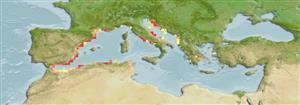Common names from other countries
Classification / Names / Names
Nomes comuns | Sinónimos | Catalog of Fishes (gen., sp.) | ITIS | CoL | WoRMS
Environment: milieu / climate zone / depth range / distribution range
Ecologia
Pelágico(a,os,as); intervalo de profundidade 1 - 50 m (Ref. 3086). Subtropical
Mediterranean: Spain.
Length at first maturity / Tamanho / Peso / Idade
Maturity: Lm ? range ? - ? cm Max length : 7.0 cm COLD macho/indeterminado; (Ref. 3086)
Nematophores present all over fascicled colony, cnidome comprising only microbasic euryteles, especially abundant on nematophore; female blastostyles partially reduced (with some remaining tentacles), spadix unbranched, mature eggs scattered along blastostyle pedicel; male blastostyles completely reduced (Ref. 3086).
Found at depths of 1 to 50 m, generally on rocks. Common in submarine caves and crevices in shallow waters and on rocks in deeper waters (Ref. 3086).
Life cycle and mating behavior
Maturidade | Reprodução | Desova | Ovos | Fecundidade | Larvas
Gonophores were found from February to March and July to October (Ref. 3086).
Marques, A.C., A.L. Peña Cantero and W. Vervoort. 2000. (Ref. 3086)
Categoria na Lista Vermelha da IUCN (Ref. 130435)
Categoria CITES (Ref. 108899)
Not Evaluated
Not Evaluated
Ameaça para o homem
Harmless
Utilização humana
| FishSource |
Ferramentas
Mais informação
Nomes comunsSinónimosPredadoresReproduçãoMaturidadeDesovaFecundidadeOvosDesenvolvimento dos ovos
Idade/TamanhoCrescimentoComprimento-pesoComprimento-comprimentoMorfologiaLarvasAbundância
Fontes da internet
Estimates based on models
Preferred temperature
(Ref.
115969): 16.2 - 18.5, mean 17.7 (based on 28 cells).
Vulnerabilidade
Low vulnerability (10 of 100).
Categoria de preço
Unknown.
